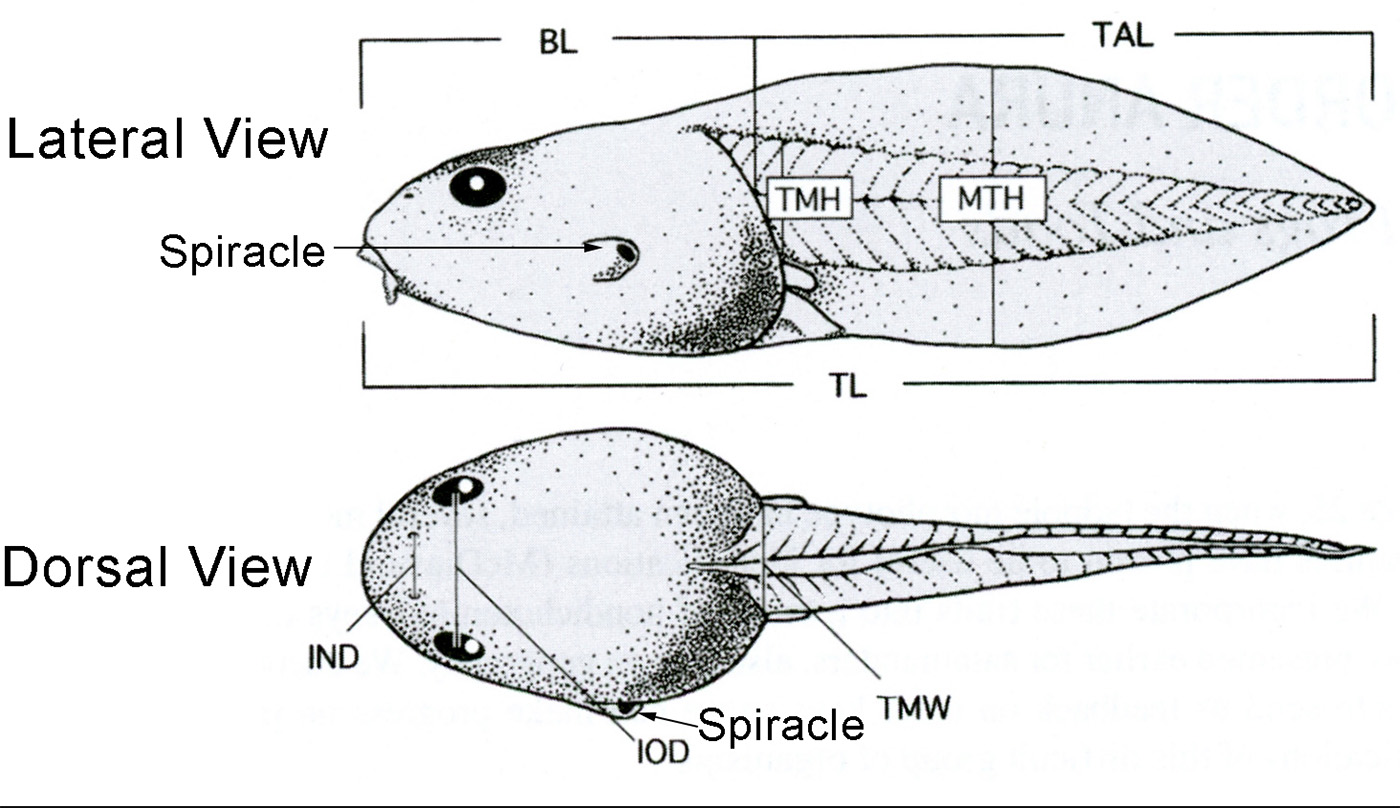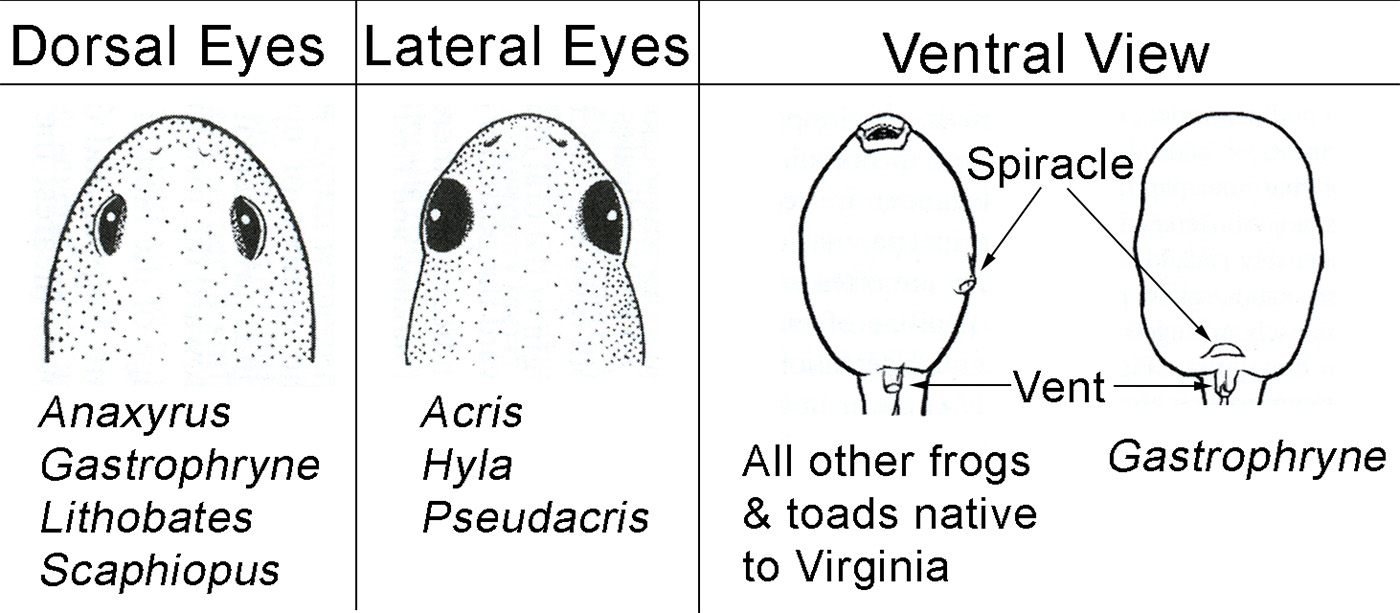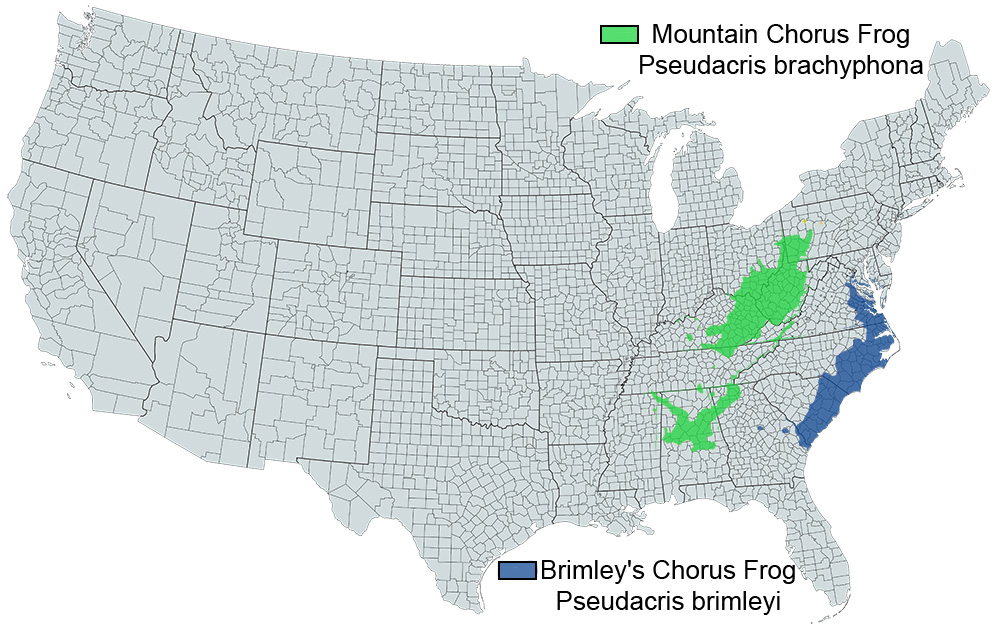Brimley's Chorus Frog
Pseudacris brimleyi
Common Name: |
Brimley's Chorus Frog |
Scientific Name: |
Pseudacris brimleyi |
Etymology: |
|
Genus: |
Pseudacris is derived from the Greek words pseudes meaning "false" and akris meaning "locust". |
Species: |
brimleyi honors Clement Samuel Brimley (1863-1946), a North Carolina naturalist. |
Average Length: |
1 - 1.3 in. (2.5 - 3.2 cm) |
Virginia Record Length: |
|
Record length: |
Physical Description - This species ranges in length from 25 to 32 mm (1 to 1-1/4 inches). The coloring is highly variable but typically this species is tan with 3 dorsal brown stripes. A dark brown or black stripe runs down each side from the nostril through the eye to the groin. The ventrum is typically yellow with brown spots on the chest. The legs of this species are marked with dark longitudinal stripes.
Historical versus Current Distribution - The historical range of Brimley's Chorus Frogs (Pseudacris brimleyi) is unknown. Their current distribution is in the Atlantic Coastal Plain from northeastern Georgia to southern Caroline County, Virginia (Hoffman, 1983; Mitchell and Reay, 1999).
Historical versus Current Abundance - There are no estimates of population size or densities. Brimley's Chorus Frogs may be locally abundant.
Life History Features - The life history and ecology of Brimley's Chorus Frogs were summarized by Wright and Wright (1949) and Gosner and Black (1958b).
Breeding - Reproduction is aquatic.
Breeding migrations - Brimley's Chorus Frogs apparently do not migrate. Initiation of the calling period depends on temperature but usually begins in February or March. Males call from perches on or beneath vegetation and usually partially submerged in water. Extreme dates of calling are 7 March–22 April in Virginia (Mitchell, 1986) and 19 February–17 April in North Carolina (Brandt and Walker, 1933). Brandt (1936a) heard calls in November. Mitchell (1986) noted egg laying from 10 March–22 April in Virginia.
Breeding habitat - This species breeds in shallow flooded fields, red maple (Acer rubrum) swamps, ditches, floodplain pools, woodland pools with sphagnum, ditches or pools in logged areas, and shrub thickets (Gosner and Black, 1958b; Mitchell, 1986; personal observations).
Egg deposition sites - Eggs are laid in small gelatinous masses attached to vegetation, usually grass stems, in shallow water.
Clutch size - Maximum known clutch size is 300 (Gosner and Black, 1958b).
Altig & McDiarmid 2015 - Classification and Description:
- Eastern Mass
- Arrangement 3 - Capsular chambers absent, so ova centered
in inner jelly layers mass usually 45 mm diameter or less (note:
particularly difficult group with minimal data).
- Sub-arrangement A - Ovum Diameter 1.3-1.7 mm; Egg Diameter 6.8-8.6 mm
- Arrangement 3 - Capsular chambers absent, so ova centered
in inner jelly layers mass usually 45 mm diameter or less (note:
particularly difficult group with minimal data).
Larvae/Metamorphosis - The larval period is short, lasting about 30–35 days and as long as 60 days (Gosner and Black, 1958b). Mitchell (1986) reported finding newly metamorphosed animals from 12 May–17 April. Size at metamorphosis is 8.6–11.0 mm (Gosner and Black, 1958b).
Tadpoles:

| Lateral View | Dorsal View |
|---|---|
| BL = Body Length | IND = Internarial Distance |
| MTH = Maximum Tail Height | IOD = Interorbital Distance |
| TAL = Tail Length | TMW = Tail Muscle Width |
| TL = Total Length | |
| TMH = Tail Muscle Height |

Juvenile Habitat - Apparently similar to that of adults.
Adult Habitat - Adults have been found well away from water in mixed pine and hardwood forests, pine forests, secondary dune scrub forest, forested wetlands dominated by red maple, loblolly pine (Pinus taeda), and sweetgum (Liquidambar styraciflua), and cultivated fields (Gosner and Black, 1958b; Buhlmann et al., 1994; personal observations).
Home Range Size - Unknown.
Territories - Unknown.
Aestivation/Avoiding Dessication - Unknown.
Seasonal Migrations - Brimley's Chorus Frogs apparently do not migrate.
Torpor (Hibernation) - Overwintering sites are apparently underground. Brandt (1936a) noted that this Frog appears to remain active throughout the winter except during freezing weather conditions.
Interspecific Associations/Exclusions - Brimley's Chorus Frogs are sympatric with American Toads (Anaxyrus americanus), Upland Chorus Frogs (Pseudacris feriarum), Spring Peepers (Pseudacris crucifer), Southern Chorus Frogs (Pseudacris nigrita), and Coastal Plains Leopard Frog (Lithobates sphenocephalus utricularius).
Mecham (1965) obtained experimental hybrids between Brimley's Chorus Frog and Mountain (P. brachyphona), Ornate (P. ornata), Southern, and Upland Chorus Frogs.
Age/Size at Reproductive Maturity - Brandt and Walker (1933) noted that the smallest male measured 24 mm and the smallest female was 27 mm. Age at first reproduction is unknown.
Longevity - Unknown.
Feeding Behavior - The diet of this frog has not been studied, but Brandt (1936b) noted that specimens he examined contained insects, spiders, and debris.
Predators - Brown (E.E., 1979) reported a Brimley's Chorus Frog in a Common Ribbonsnake (Thamnophis sauritus) from North Carolina.
Anti-Predator Mechanisms - Unknown.
Diseases - Unknown.
Parasites - Brandt (1936b) found ten species of protozoans (mostly opalinids), two species of trematodes, seven nematodes, and one acanthocephalan in 55 individuals from North Carolina.
Conservation - Brimley's Chorus Frogs are not listed in any state in which they occur, but regulations in Virginia do not allow commercialization (Levell, 1997).
References
- Altig, Ronald & McDiarmid, Roy W. 2015. Handbook of Larval Amphibians of the United States and Canada. Cornell University Press, Ithaca, NY. 341 pages.
- AmphibiaWeb. 2020. University of California, Berkeley, CA, USA.
- Conant, Roger and, Collins, John T., 2016, Peterson Field Guide: Reptiles and Amphibians, Eastern and Central North America, 494 pgs., Houghton Mifflin Company., New York
- Duellman, William E. and, Trueb, Linda, 1986, Biology of Amphibians, 671 pgs., The Johns Hopkins University Press, Baltimore
- Martof, B.S., Palmer, W.M., Bailey, J.R., Harrison, III J.R., 1980, Amphibians and Reptiles of the Carolinas and Virginia, 264 pgs., UNC Press, Chapel Hill, NC
- Wilson, L.A., 1995, Land manager's guide to the amphibians and reptiles of the South, 360 pp. pgs., The Nature Conservancy, Southeastern Region, Chapel Hill, NC
Photos:
*Click on a thumbnail for a larger version.
Verified County/City Occurrence
Caroline
Charles City
Chesterfield
Gloucester
Hanover
Isle of Wight
James City
Mathews
New Kent
Prince George
Southampton
Spotsylvania
Sussex
York
CITIES
Chesapeake
Emporia
Newport News
Portsmouth
Suffolk
Virginia Beach
Verified in 14 counties and 6 cities.
U.S. Range










01-sm.jpg)
02-sm.jpg)
03-sm.jpg)
04-sm.jpg)



